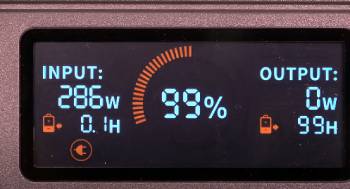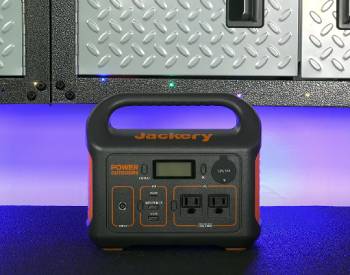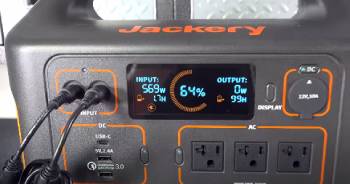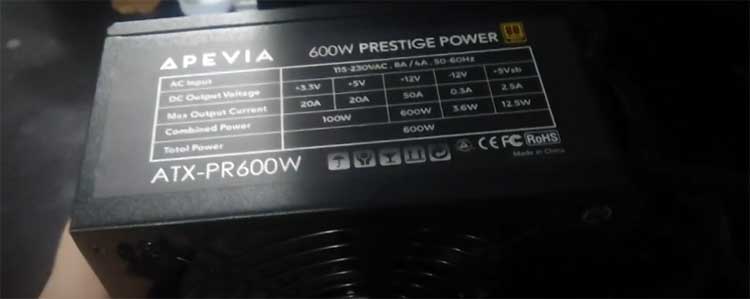If you’ve been thinking about getting a reliable, quiet, and surprisingly powerful portable power station, the Jackery Explorer 1500 is a smart pick.
Whether you’re camping, preparing for blackouts, or just want energy independence, this machine delivers.
I bought it to simplify my road trips and emergency planning—and it’s been worth every cent.
Let me take you through what it’s really like owning the Explorer 1500, so you can decide if it’s the backup power solution you’ve been searching for.
My Experience Using the Jackery Explorer 1500

I bought the Jackery Explorer 1500 right before a two-week solo road trip. I’d already owned the smaller Jackery 240, which served me well for short getaways, but I needed something more robust to keep up with longer off-grid excursions—and more gear.
My first impression of the Explorer 1500 was that it looked tough and professional. Not flashy, but designed with purpose.
What sold me was the 1800W output power. I wasn’t just running my phone, a light, and a mini-fridge—I needed to power my CPAP machine every night, charge a laptop, run a small heater, and even plug in power tools from time to time. With its 1534Wh battery, this unit handled it all.
On the first night camping in a snowy mountain pass, the Jackery powered my CPAP and a small heater through the entire night without a hiccup.
The battery percentage dropped, of course, but it still had enough juice to brew coffee the next morning and top up my phone and camera gear. That kind of reassurance when you’re in freezing weather, alone, is priceless.
One thing to watch out for is temperature sensitivity. It doesn’t operate well in extreme cold, but the device gives a warning light when it’s too cold to function. I kept it in a sleeping bag overnight to avoid that issue—problem solved.
I also tested it at home by powering a corded drill, a jigsaw, and even a chop saw for some weekend DIY work.
I expected the battery to drain quickly, but after nearly three hours of active use, I still had half a charge left. It surprised me.
It also recharges faster than I thought—around 4 hours with wall AC, and not much longer using the solar panels on a good day.
What impressed me most was its silent operation. No humming, no engine noises, just power on demand. This is especially important for anyone using medical devices or traveling in noise-sensitive areas.
In short, this thing handled everything I threw at it—without ever complaining. It’s not light, but I’m 71 and can still carry it around without much struggle. That says something about its smart design.
Maintenance Tips for the Jackery Explorer 1500

- Keep it at Room Temperature: Always store and use your Jackery in environments between 14°F to 104°F. Extreme cold or heat affects battery efficiency. If you’re camping in cold weather, keep the unit insulated overnight—like in a blanket or sleeping bag.
- Recharge Every Three Months: Even if you’re not using it, make it a habit to top up the battery at least every 3 months. This keeps the cells active and prolongs battery life. Letting it sit at 0% for long periods can reduce capacity.
- Use Soft Charging Cycles: Whenever possible, avoid draining the battery to 0%. Stop usage around 10-15% to maintain long-term health. It’s the same principle that applies to your phone or laptop batteries.
- Avoid Overloading the System: While 1800W is powerful, exceeding that (even momentarily) can trigger protection mode. Know the wattage of what you’re plugging in. If you run multiple devices at once, make sure their combined draw doesn’t exceed the limit.
- Wipe it Clean Occasionally: Dust and grime can accumulate around ports and cooling vents. Use a dry microfiber cloth to clean the unit regularly and inspect ports for debris or corrosion.
- Protect the Ports: Use the included rubber port covers or keep the device in a dry, closed space when not in use. This protects it from moisture and prevents dust from settling into the outlets.
- Charge Fully Before Storage: If you’re storing it for a season or longer, fully charge it first. Don’t store it empty—it can go into low-battery protection mode and require manual resets.
- Inspect for Firmware Updates: Jackery occasionally releases firmware updates, so check their site periodically. Even without app integration, keeping your firmware up to date ensures peak performance.
- Don’t Block the Cooling Vents: Make sure the cooling fan has room to breathe, especially during heavy usage. Keep it upright on a hard surface and never set it down on blankets or soft bags.
Pros and Cons of Jackery Explorer 1500

Pros:
- Powerful Output: With a full 1800W AC output, it runs high-draw appliances like saws, fridges, space heaters, and CPAP machines without issue.
- Whisper-Quiet Operation: There’s virtually no noise when it’s in use, making it ideal for nighttime use or silent camping.
- Fast Charging: Charges from 0% to 80% in just 4 hours via AC wall outlet or four 100W solar panels—pretty impressive for such a large battery.
- Reliable Battery Retention: After 60 days of sitting unplugged, mine still held over 95% charge, which proves its battery quality and longevity.
- Pass-Through Charging: You can charge it while using it to power other devices, a feature many power stations lack.
- Safe and Durable: The battery is UL-certified, impact-resistant, and designed with EV-grade cylindrical cells for high safety and performance standards.
- Easy to Use: Setup is foolproof—just one button to start. Plus, the handle is ergonomic and makes carrying it less of a chore.
- Wide Range of Outlets: With 7 ports (AC, USB-A, USB-C, and car outlet), you can charge everything from phones to power tools simultaneously.
Cons:
- Heavy: Weighing around 35 pounds, it’s not ideal if you’re planning to backpack or hike far with it.
- Pricey: The cost is high, especially once you add the solar panels—but you’re paying for reliability and peace of mind.
- Cold Sensitivity: If the temperature drops too low, the device may temporarily stop working until warmed up.
- No Expandable Battery Option: Unlike some newer models, you can’t daisy-chain this with additional batteries to extend its capacity.
- Limited App Control: It doesn’t come with a Bluetooth app to monitor usage remotely, which would be useful in some settings.
Also Read: Jackery Vs. Goal Zero Vs. Anker Portable Power Station
Jackery Explorer 1500 Vs. Other Brands
- Jackery Explorer 1500 Vs. Goal Zero Yeti 1500X
The Goal Zero Yeti 1500X is another heavy hitter in the portable power station game, but having used both, I prefer the Jackery for a few key reasons. For starters, Jackery charges faster with solar panels thanks to its MPPT controller, while the Yeti’s setup felt finicky and a bit less intuitive.
The Explorer 1500 also comes ready to use right out of the box with no app dependency. While Goal Zero offers Bluetooth connectivity and app monitoring, I found it unnecessary for most basic users. Plus, Jackery is quieter and has better passive battery retention.
Weight-wise, they’re similar, but Jackery’s ergonomic handle makes it easier to carry, especially for older users like myself. As far as output, both are neck-and-neck, but Jackery’s real-world battery efficiency and reliability sealed the deal for me.
- Jackery Explorer 1500 Vs. Bluetti AC200P
Bluetti’s AC200P is known for raw power and high surge capacity. However, that comes with added complexity. Jackery keeps it simple—one button, one screen, one handle. I liked that about it.
The Bluetti has more ports and supports up to 2000W, but it’s bulkier and takes longer to charge. Jackery, with 1800W and a slightly smaller battery, still powers the same devices with ease but recharges much faster via AC or solar.
Bluetti does allow for expandable battery options, which Jackery lacks, but unless you need serious off-grid living setups, the Explorer 1500 handles more than enough for short to medium trips or emergencies.
- Jackery Explorer 1500 Vs. EcoFlow Delta Max
EcoFlow’s Delta Max is famous for its fast charging and futuristic design. It beats Jackery in recharge speed by a small margin. However, that comes with higher fan noise. Jackery is almost silent, which made a huge difference to me at night while running medical devices.
Delta Max also has app support, which Jackery doesn’t offer. That’s nice for tech-savvy users, but for folks who just want plug-and-play reliability, Jackery wins hands down. In terms of battery life and charge retention, I trust Jackery more—it held charge longer in storage than my friend’s Delta.
- Jackery Explorer 1500 Vs. Anker PowerHouse 757
Anker’s PowerHouse 757 is newer and has a great display, but it’s heavier and feels less rugged to me. Jackery’s build is rock solid and has proven drop resistance—something Anker doesn’t highlight.
Both have similar output capabilities, but Jackery gives you more practical use cases with better battery health over time. If you’re planning long-term use in outdoor settings, Jackery is more field-tested.
- Jackery Explorer 1500 Vs. Generark HomePower One
Generark positions itself as an emergency home power source, and while it does that well, it lacks the versatility of the Jackery. The Explorer 1500 is both a camping essential and home backup, while Generark leans more toward stationary use.
In real-life usage, Jackery charged faster, lasted longer, and was quieter. For anyone needing multi-scenario power, Jackery is simply more flexible.
Also Read: Jackery Vs. Bluetti Vs. Goal Zero Portable Power Stations
Frequently Asked Questions (FAQs)
On average, it can run a standard energy-efficient refrigerator (around 150W) for roughly 10 hours continuously. If your fridge cycles off and on, it may last longer—up to 24 hours in some cases.
With proper maintenance, the Explorer 1500 will last 5–7 years or more. It’s rated for over 500 full charge cycles before battery capacity drops significantly.
It can power almost anything under 1800W. This includes CPAP machines, microwaves, refrigerators, TVs, laptops, coffee makers, electric grills, saws, and more.
Yes, but only smaller portable AC units under 1800W. You’ll need to check your specific unit’s wattage draw. It won’t run central or window units for long durations.
Final Thoughts
If you’re looking for reliable power that won’t let you down during emergencies, road trips, or DIY tasks, the Jackery Explorer 1500 is a powerhouse.
It’s quiet, durable, and easy to use—even for someone like me with no tech background. This thing has earned its spot in my gear, and I wouldn’t hit the road or prep for storm season without it.
